Categories > Guides and Tips

Thailand 101: Our Ultimate Guide to Thai Culture
- Thai Language: Communication and Expression
- Thai is a tonal language with its own distinctive script
- Thai culture puts strong emphasis on politeness and respect
- Thai language has a range of pronouns
- Thai language is rich in expression of emotions and feelings
- Nonverbal cues play a significant role in Thai communication
- Thai language preserves and promotes Thai cultural identity
- Learning basic Thai phrases is highly appreciated by locals
- Thai Religion and Beliefs
- Theravada Buddhism is the most widely practised religion
- Thailand is adorned with magnificent Buddhist temples
- Buddhist monks hold great reverence in Thai culture
- Merit-making is a core practice in Thai Buddhism
- Thailand celebrates a myriad of colourful religious festivals
- Thailand also has a harmonious blend of beliefs
- Showing respect for sacred symbols and objects is crucial
- Thai Culture & Society: Rich Traditions and Heritage
- Thailand has an array of traditional arts and performances
- Thai cuisine is known globally for its explosion of flavours
- Thai traditional attire adds to the allure of the culture
- Thai Social Etiquette and Customs
- Thais are generally reserved when it comes to public displays
- Thai culture values harmony and avoiding conflict
- Mealtimes in Thailand are a social event
- Gift-giving is a cherished tradition in Thai culture
- Dressing modestly is essential when visiting temples
- Thai Business Protocol and Work Culture
- Thai culture puts a strong emphasis on hierarchy
- Thai work culture emphasises teamwork
- Thais value work-life balance
- Business meetings in Thailand tend to be formal affairs
Are you ready for an extraordinary adventure through the vibrant tapestry of Thai culture?
Thailand, often referred to as the “Land of Smiles,” is a mesmerising country that boasts an ancient history, breathtaking landscapes, and a cultural diversity like no other.
Thai culture is a captivating blend of tradition and modernity, deeply rooted in Buddhism. It features exquisite arts, mouthwatering cuisine, and vibrant festivals.
Respect for elders, social harmony, and warm hospitality are at its core, making Thailand a truly enchanting and welcoming destination.
In this guide, we’ll uncover the essence of Thai life, uncovering the significance of their language, delving into their deeply-rooted religious beliefs, understanding their social customs, and even gaining insights into their business practices.
Thai Language: Communication and Expression
Thai is a tonal language with its own distinctive script
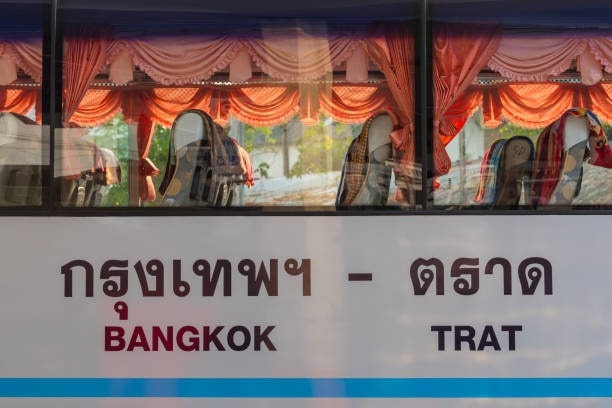
The Thai language is unique for its tonal nature, where the pitch or tone in which a word is pronounced can completely change its meaning.
There are five tones in Thai: high, mid, low, falling, and rising. For example, the word “ma” can mean “dog” in a high tone, “come” in a mid tone, “horse” in a low tone, “come in” in a falling tone, and “silk” in a rising tone.
Mastering the correct tone is essential for effective communication and avoiding misunderstandings in daily conversations.
The script used to write Thai is equally captivating. Known as “Thai script” or “Thai alphabet,” it is an abugida system, which means that consonants are written with an inherent vowel sound, and additional marks indicate other vowel sounds.
Its graceful curves and intricate characters add to the cultural beauty and artistic essence of Thai writing.
Thai culture puts strong emphasis on politeness and respect
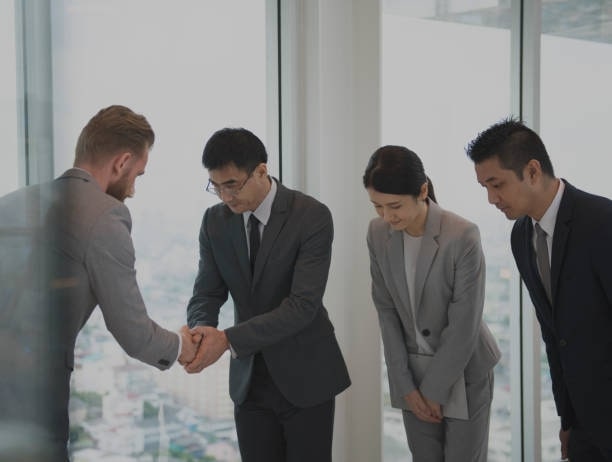
Politeness and respect are fundamental values in Thai culture, influencing every aspect of daily life and interactions. From greetings to farewells, Thais use polite forms of speech and gestures to show respect to one another.
Addressing others with honorific titles, using the appropriate pronouns, and avoiding confrontations are essential elements of Thai politeness.
In Thai society, showing respect for elders, teachers, and authority figures is deeply ingrained. Bowing as a sign of respect and never raising one’s voice in public are common cultural practices.
The emphasis on politeness fosters a harmonious and polite society where people coexist with mutual respect and consideration for others’ feelings.
Thai language has a range of pronouns

The Thai language boasts a diverse array of pronouns, reflecting the social status and relationship between individuals. These pronouns serve to indicate the level of respect and familiarity one has with another person.
Thais often use different pronouns when addressing family members, friends, colleagues, or strangers.
For instance, chan is a common pronoun used by women to refer to themselves, while phom is the equivalent pronoun used by men.
Additionally, “khrap” and “ka” are polite particles added to the end of sentences to signify respect and politeness when speaking with someone of higher social status or age.
Thai language is rich in expression of emotions and feelings

The Thai language is remarkably expressive, allowing individuals to articulate a wide range of emotions and feelings. Thais often use descriptive words, idioms, and metaphors to convey complex emotions with precision and grace.
For example, the word “nam jai” refers to the concept of emotional warmth, kindness, and generosity. “Glua,” on the other hand, expresses a sense of embarrassment or shyness.
By skillfully using these words, Thais can communicate their sentiments and experiences more profoundly, fostering deep connections and understanding in conversations.
Nonverbal cues play a significant role in Thai communication
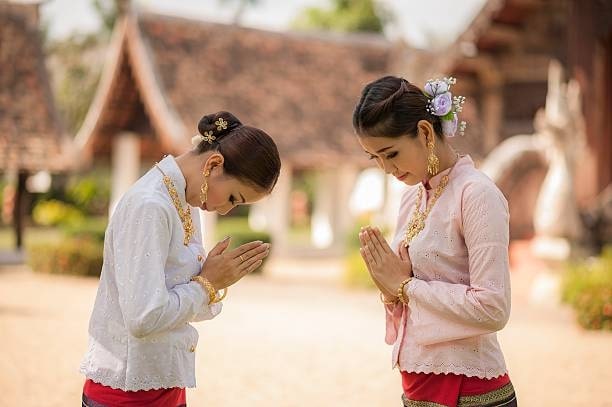
In Thai culture, communication goes beyond spoken words. Nonverbal cues, such as facial expressions, gestures, and body language, play a crucial role in conveying meaning and intentions.
Thais often use smiles to indicate politeness, happiness, or to diffuse awkward situations.
A traditional Thai greeting, the wai, involves placing the palms together in a prayer-like gesture while bowing slightly.
The wai is used as a sign of respect, gratitude, or as a formal greeting. Understanding these nonverbal cues is essential for interpreting messages accurately and contributing to smoother interactions.
Thai language preserves and promotes Thai cultural identity
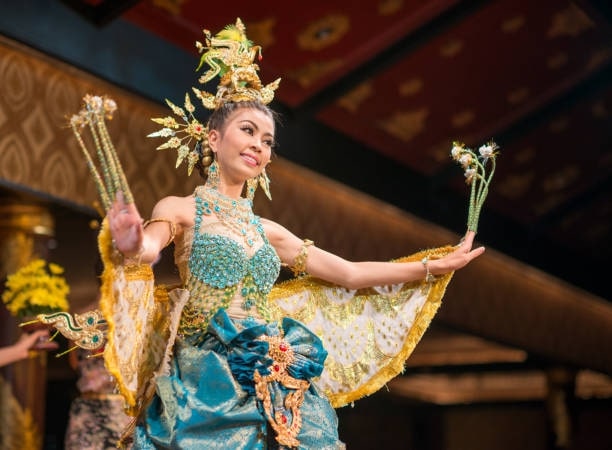
The Thai language is a powerful tool in preserving and promoting Thai cultural identity. It is not just a means of communication but a repository of wisdom, history, and traditions passed down through generations.
By using the Thai language, Thais reinforce a sense of unity and belonging, fostering a shared cultural heritage that unites the nation.
Furthermore, traditional Thai literary works, such as ancient poetry and religious texts, are written and recited in the Thai language, keeping the cultural legacy alive.
Language becomes a vessel to carry the values, beliefs, and customs that define the essence of being Thai.
Learning basic Thai phrases is highly appreciated by locals
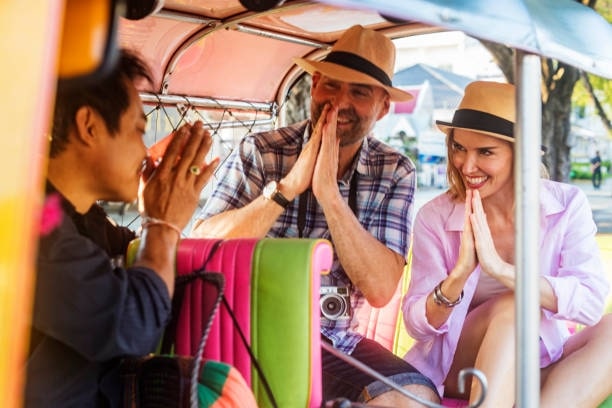
When visiting Thailand, making an effort to learn basic Thai phrases can go a long way in establishing connections with the locals.
While English is widely spoken in tourist areas, showing an interest in the local language demonstrates respect for the culture and the people.
Simple greetings like sawasdee (hello) and khob khun (thank you) are met with warm smiles and appreciation from Thais.
Using these phrases during interactions creates a friendly atmosphere and opens doors to more authentic cultural experiences.
Locals will often be delighted to help you improve your language skills and will cherish the effort you put into understanding their language and culture.
Thai Religion and Beliefs
Theravada Buddhism is the most widely practised religion
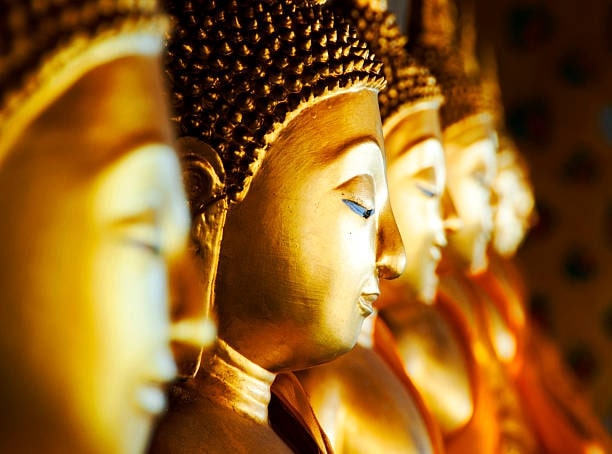
Theravada Buddhism holds a central place in Thai culture, shaping the spiritual and ethical values of the nation.
Practiced by the majority of Thais, this ancient branch of Buddhism focuses on the teachings of Siddhartha Gautama (Buddha) and emphasizes individual enlightenment through meditation and moral living.
Monasteries and temples are the heart of Theravada Buddhism, providing spaces for monks to lead a monastic life and for devotees to seek spiritual guidance.
Buddhist teachings are deeply integrated into daily life, influencing social behaviour, decision-making, and interactions with others.
The principles of compassion, non-violence, and mindfulness resonate throughout Thai society, creating a foundation for a harmonious and peaceful way of life.
Thailand is adorned with magnificent Buddhist temples
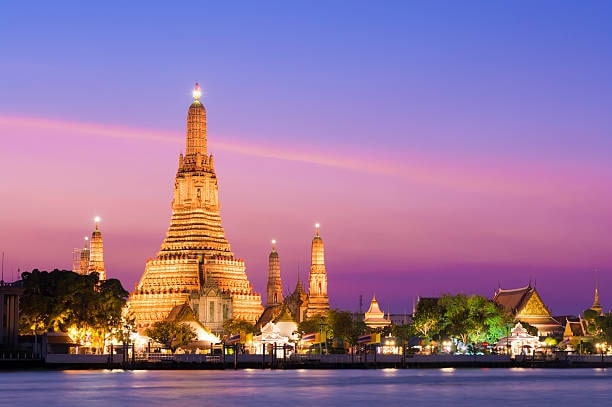
As you traverse through Thailand’s landscape, it becomes evident that the country is a treasure trove of exquisite Buddhist temples, locally known as wats.
Each temple showcases unique architectural styles, artistic details, and ornate decorations that reflect the rich historical and cultural heritage of the region.
From the opulence of the Grand Palace and Wat Phra Kaew in Bangkok to the serenity of Wat Pho with its iconic reclining Buddha, these temples stand as awe-inspiring symbols of devotion and spiritual sanctuaries.
The intricate carvings, golden spires, and vibrant murals create a visual feast, drawing in locals and visitors alike to appreciate the beauty and sacredness of these architectural marvels.
Buddhist monks hold great reverence in Thai culture
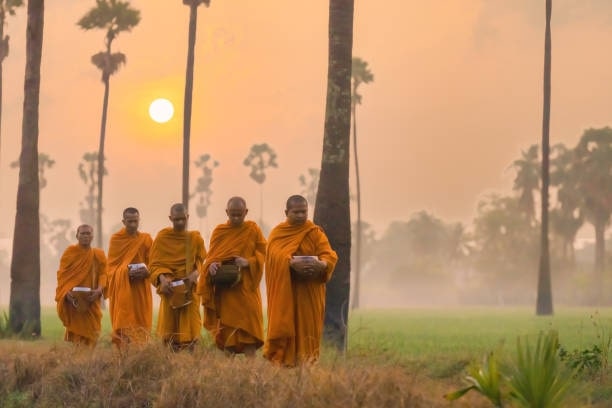
Buddhist monks are deeply revered in Thai society, symbolizing spiritual purity, wisdom, and selflessness.
Monastic life is highly respected, and many young Thai men undertake temporary ordination as monks, known as “novices,” as a rite of passage.
The sight of saffron-robed monks walking serenely through bustling streets to collect alms is a common scene in Thailand.
Plus, the act of offering food and other necessities to monks is considered a virtuous deed, allowing the laity to accumulate merit and express their gratitude for the monks’ spiritual guidance.
Monks often play a significant role in conducting religious ceremonies, providing blessings, and offering counsel to the community.
Their presence at major life events, such as weddings and funerals, is believed to bring blessings and auspiciousness to the occasions.
Merit-making is a core practice in Thai Buddhism
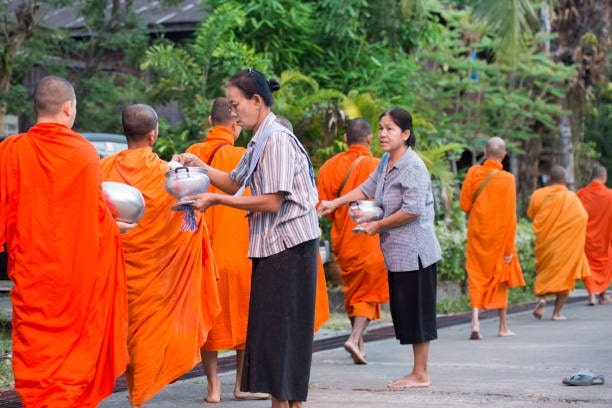
Merit-making, known as tam bun, is a fundamental aspect of Thai Buddhist practice.
Devotees engage in acts of generosity, selflessness, and moral virtue to accumulate merit, which is believed to pave the way for a better future and to enhance spiritual growth.
Offering alms to monks, making donations to temples, participating in religious ceremonies, and engaging in acts of kindness towards others are all considered meritorious deeds.
By practising merit-making, Thais seek to bring positive energy and good karma into their lives and the lives of their loved ones.
Merit-making also extends to deceased family members, with people dedicating merit to their ancestors through various rituals and offerings.
Thailand celebrates a myriad of colourful religious festivals
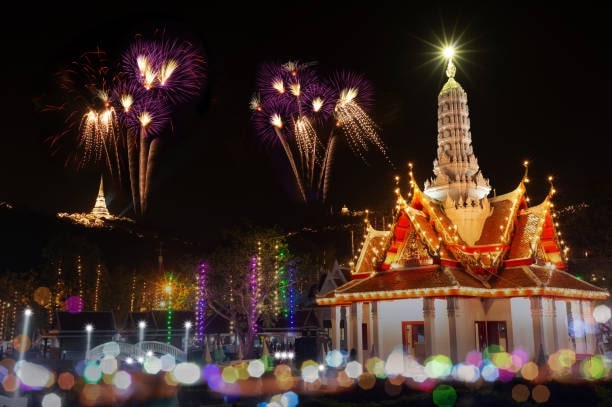
Thailand’s calendar is punctuated by an array of vibrant religious festivals, each celebrated with zeal and enthusiasm. These festivals provide a glimpse into the cultural diversity and the spirit of celebration that permeates the country.
One of the most famous festivals is Songkran, the Thai New Year, celebrated in April. It is marked by joyous water fights, symbolizing cleansing and renewal for the coming year.
Loy Krathong, the festival of lights, is another significant celebration where people float intricately crafted baskets on waterways, symbolizing the release of negativity and paying respect to the goddess of water.
Other festivals include Makha Bucha, Visakha Bucha, and Asalha Bucha, which commemorate important events in Buddha’s life. These occasions are marked with temple visits, candlelight processions, and acts of devotion.
Thailand also has a harmonious blend of beliefs
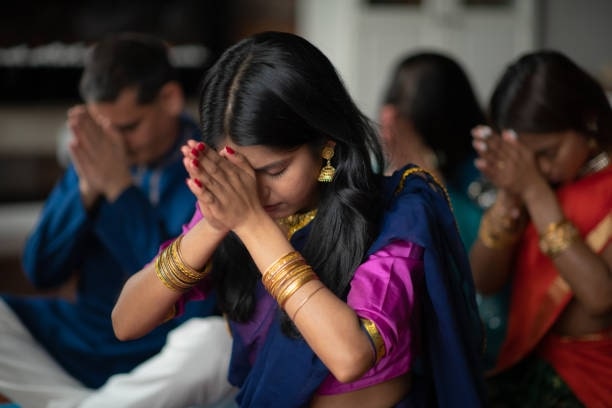
Thailand’s cultural landscape is not confined to a single religion; it embraces a harmonious blend of beliefs.
Alongside Buddhism, elements of animism, Hinduism, and local folk traditions coexist, showcasing the country’s inclusive and syncretic approach to spirituality.
Local spirits and deities, known as phi and devaraja, are revered by communities and are an integral part of Thailand’s spiritual tapestry.
Ancient animistic beliefs in nature spirits, guardian spirits, and household deities remain alive in Thai culture, influencing daily rituals and customs.
Hindu influences are evident in certain Thai customs and rituals, such as the use of the Garuda as a national symbol and the celebration of Loy Krathong, which has roots in a Hindu festival.
This harmonious blend of beliefs allows Thais to respect and draw from various spiritual traditions, fostering a sense of cultural openness and understanding among diverse communities.
Showing respect for sacred symbols and objects is crucial
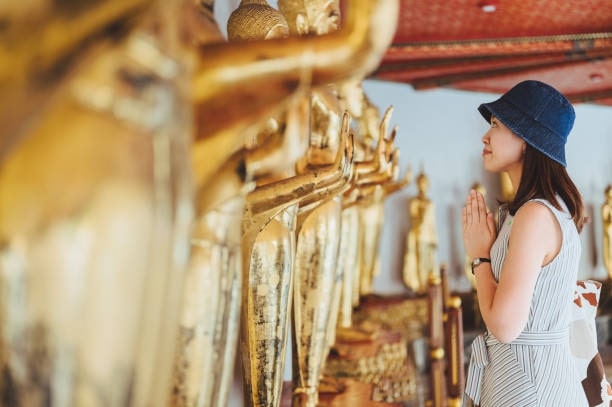
Thailand holds its sacred symbols and religious objects in high esteem. Temples, Buddha images, and religious artefacts are considered highly sacred and deserving of utmost respect.
When visiting temples, it is customary to dress modestly, cover shoulders and knees, and remove shoes before entering temple premises.
Pointing feet towards Buddha images or other sacred objects is considered disrespectful, as feet are considered the lowest part of the body in Thai culture.
Furthermore, public displays of affection are generally avoided in temple areas to maintain an atmosphere of reverence and spirituality.
Thai Culture & Society: Rich Traditions and Heritage
Thailand has an array of traditional arts and performances
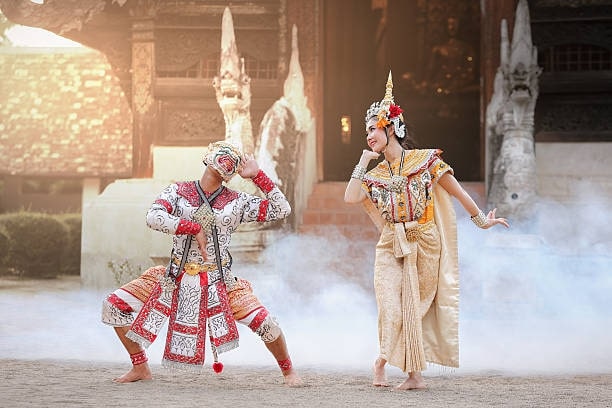
Thailand’s cultural canvas is adorned with a splendid array of traditional arts and performances that showcase the country’s deep-rooted heritage and creativity.
For example, Thai classical dance forms like Khon,which often depicts episodes from the Ramakien (the Thai version of the Indian epic Ramayana), exude grace, elegance, and intricate movements.
Thai classical music, represented by piphat and mahori ensembles, showcases the artistic harmony of traditional instruments such as the ranat thum (xylophone), saw duang (a two-stringed fiddle), and khlui (bamboo flute).
The melodic symphony and rhythmic beats mesmerise listeners, transporting them into the heart of Thai culture.
Additionally, the traditional art of Nang Talung (shadow puppetry) brings to life characters and tales from Thai literature and folklore through intricately designed leather puppets manipulated behind a translucent screen.
Thai cuisine is known globally for its explosion of flavours
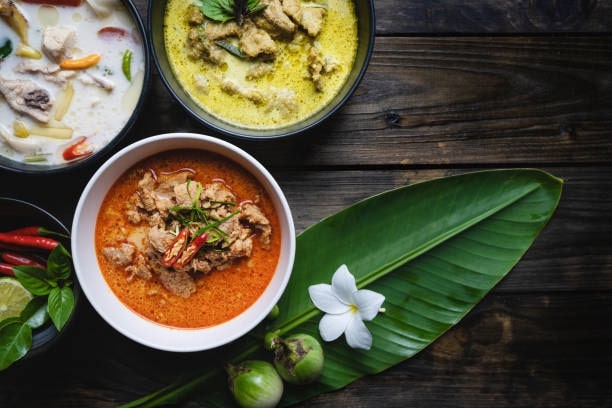
Thai cuisine is a gastronomic treasure trove that tantalizes taste buds with its harmonious blend of flavours, aromas, and textures.
It’s celebrated worldwide for its distinctive combination of sweet, sour, spicy, salty, and umami tastes, creating a symphony of sensations on the palate.
Iconic dishes like tom yum goong, a hot and sour shrimp soup, and pad thai, a flavorful stir-fried noodle dish, have gained international acclaim and become synonymous with Thai cuisine.
The generous use of aromatic herbs and spices, such as lemongrass, Thai basil, galangal, and chilli, infuses Thai dishes with their signature zest.
Thai meals are characterised by their communal nature, with an array of dishes served at once, encouraging sharing and fostering a sense of togetherness.
The art of Thai cooking lies not just in the flavours but also in the meticulous presentation, often involving intricate vegetable carvings and colourful garnishes that delight the eyes as much as the taste buds.
From bustling street food stalls to sophisticated fine-dining establishments, Thai cuisine continues to captivate food enthusiasts worldwide, earning its reputation as one of the most beloved and flavoursome cuisines globally.
Thai traditional attire adds to the allure of the culture
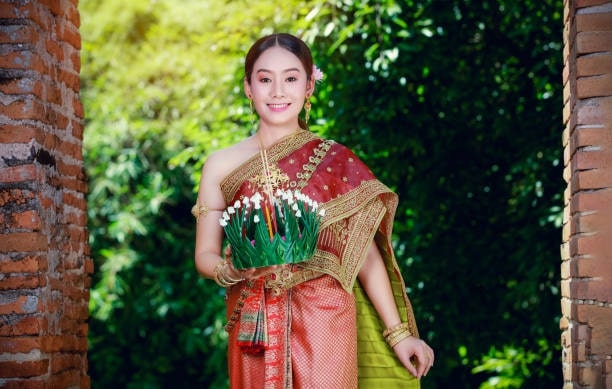
Thai traditional attire, known as Chut Thai, is a graceful and captivating aspect of the country’s culture, reflecting the elegance and beauty of Thai identity.
The attire varies based on gender, occasion, and region, and each ensemble is a delightful combination of vibrant colours, intricate designs, and luxurious fabrics.
During special occasions, festivals, and cultural events, locals proudly adorn their traditional attire, adding a touch of regal splendour to the celebrations.
The intricate designs and colourful fabrics symbolise the nation’s deep-rooted appreciation for artistic expression and cultural heritage.
Wearing traditional attire is not only a reflection of Thai identity but also an expression of pride in preserving and showcasing the country’s rich cultural legacy.
The allure of Thai traditional clothing lies in its timelessness and ability to transport wearers and onlookers to an era where grace, tradition, and beauty converge.
Thai Social Etiquette and Customs
Thais are generally reserved when it comes to public displays

In Thai culture, public displays of affection (PDA) are not common, and Thais generally maintain a reserved demeanour in public settings.
Expressing romantic affection, such as hugging, kissing, or holding hands, is typically done discreetly and reserved for more private environments.
This cultural norm is rooted in the value of maintaining decorum and respecting the boundaries of personal space in public places.
Instead of overt physical affection, Thais often show care and consideration through other gestures.
The reserved nature in public allows for a more subtle and respectful way of interacting with others, creating a harmonious atmosphere in social settings.
Thai culture values harmony and avoiding conflict

Harmony and maintaining a sense of unity are deeply cherished in Thai culture. Thais prioritize maintaining peaceful relationships and avoiding confrontations.
Open displays of anger or raising one’s voice in public are generally frowned upon, as they disrupt the harmony of the social environment.
In situations of disagreement or conflict, Thais often resort to indirect communication, seeking compromises, or finding middle-ground solutions.
Saving face and preserving the dignity of others are also crucial aspects of resolving disputes amicably.
This emphasis on harmony and avoiding confrontation fosters a cooperative and amiable society, where maintaining positive relationships takes precedence.
Mealtimes in Thailand are a social event
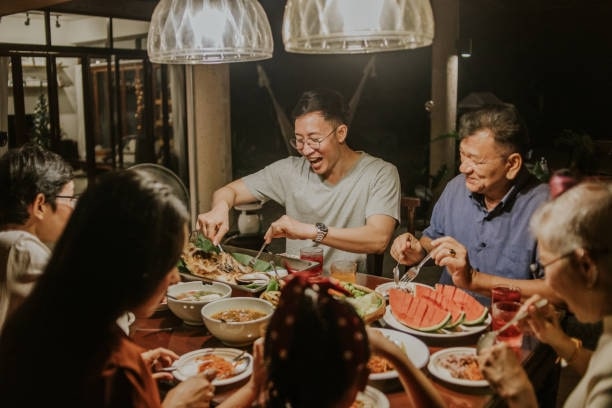
Thai meals are much more than just an opportunity to satiate hunger; they are cherished as social gatherings that bring people together.
Whether it’s a family dinner at home, a meal with friends, or dining at a local eatery, sharing food is an integral part of Thai culture and an occasion for bonding.
During mealtimes, several dishes are served simultaneously, allowing diners to sample a variety of flavours and textures.
The act of sharing dishes fosters a communal atmosphere, where people enjoy each other’s company and engage in lively conversations.
Thai meals are often accompanied by laughter, storytelling, and warm hospitality. The host ensures that guests are well-fed and comfortable, while guests express gratitude and appreciation for the delicious food and welcoming atmosphere.
Gift-giving is a cherished tradition in Thai culture
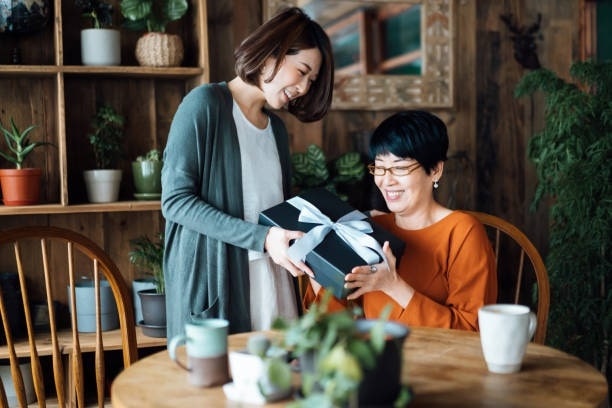
Gift-giving holds a special place in Thai culture and is an important way to express gratitude, respect, and appreciation.
Whether it’s for special occasions, religious events, or social gatherings, giving and receiving gifts is considered a thoughtful gesture that strengthens personal connections.
When presenting a gift in Thailand, the presentation and thoughtfulness are essential. Gifts are often beautifully wrapped and presented with both hands as a sign of respect.
The act of gift-giving goes beyond the material aspect; it symbolises the value placed on relationships and the effort to show care and consideration for others.
Likewise, receiving a gift is accompanied by graciousness and gratitude. Thais typically open gifts in private to appreciate the gesture fully, and it is considered impolite to be overly eager or show off the contents immediately.
The exchange of gifts fosters a sense of reciprocity and camaraderie, further enriching the social fabric of Thai society.
Dressing modestly is essential when visiting temples
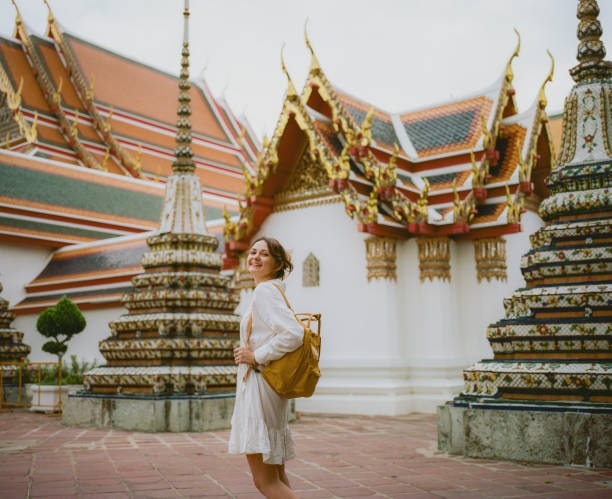
Temples hold great spiritual significance in Thai culture, and visiting these sacred sites is an integral part of Thai life. When entering temple grounds, dressing modestly is of utmost importance as a mark of respect to the sacred environment.
Both men and women should cover their shoulders and knees when visiting temples. For women, wearing sleeveless tops or revealing clothing is discouraged.
Long skirts or pants are preferred to show reverence to the sacred space. Men should also avoid wearing tank tops or shorts that expose the knees.
Additionally, removing shoes before entering the temple premises is customary to maintain cleanliness and purity within the sacred space. Observing the dress code when visiting temples showcases cultural sensitivity and respect for Thai customs and beliefs.
Thai Business Protocol and Work Culture
Thai culture puts a strong emphasis on hierarchy

In Thai society, hierarchy plays a significant role, influencing interactions and social relationships. Respecting authority and seniority is essential, and individuals are expected to show deference to those in higher positions.
This hierarchical structure is reflected in the business world, where decisions often come from top-level executives, and proper honorific titles are used when addressing superiors.
Thai work culture emphasises teamwork

Collaboration and teamwork are highly valued in Thai work culture. Employees are encouraged to work together towards shared goals, and group harmony is prioritised over individual achievements.
In this collaborative environment, employees share responsibilities and contribute their unique skills to achieve collective success.
Thais value work-life balance

While Thais are hardworking and dedicated professionals, they also prioritize maintaining a healthy work-life balance.
Personal well-being and family commitments are considered essential for overall happiness and productivity. Employers often provide benefits and flexible working arrangements to support employees’ well-being.
Business meetings in Thailand tend to be formal affairs

In the professional realm, business meetings in Thailand follow a formal approach. Participants begin with polite greetings and engage in small talk before delving into business matters.
Punctuality is highly regarded, and arriving late may be seen as disrespectful. Thais conduct themselves with decorum and professionalism during meetings, emphasizing mutual respect and maintaining a harmonious atmosphere.





